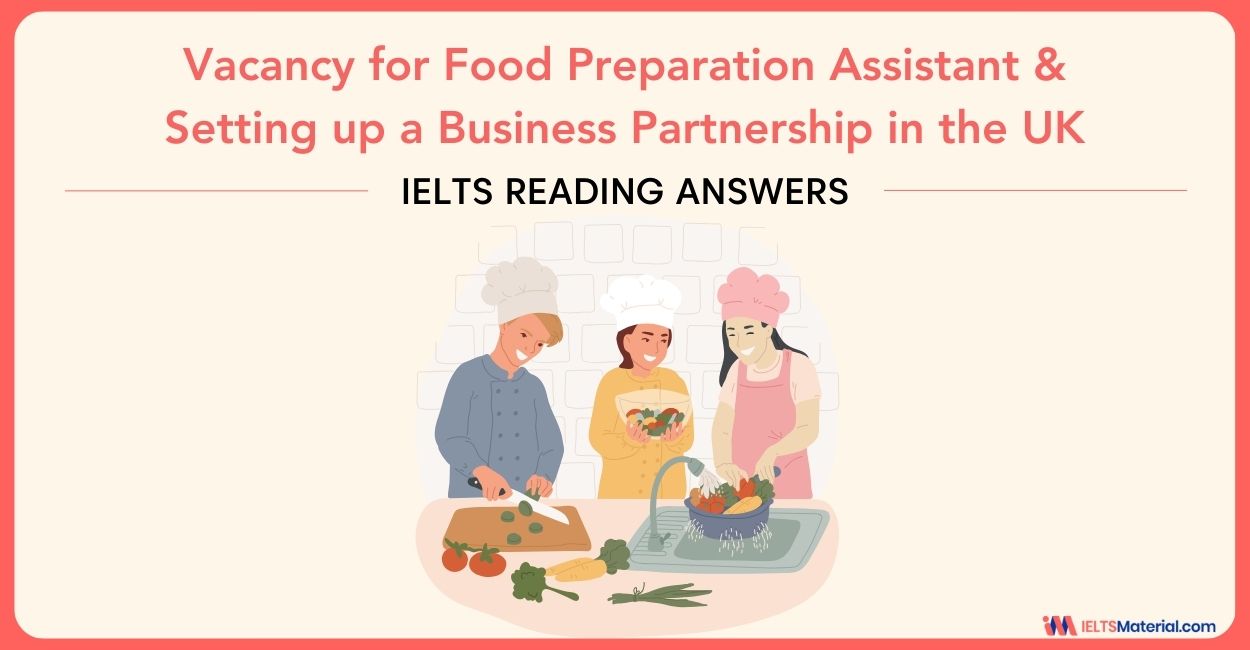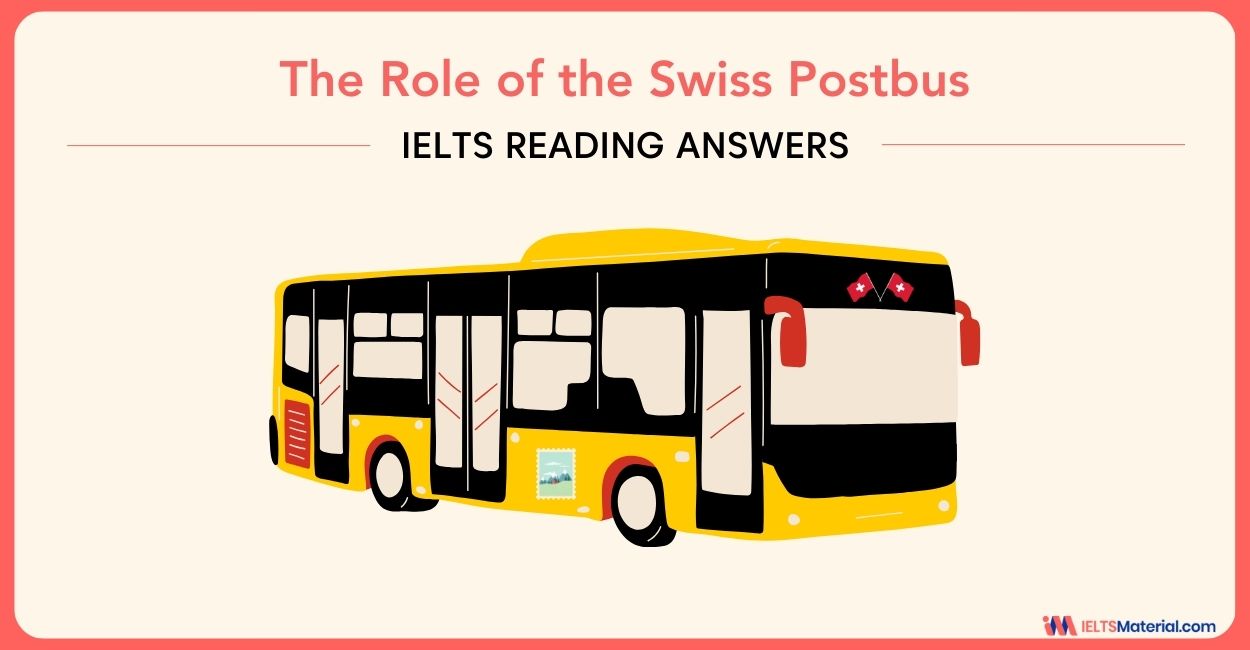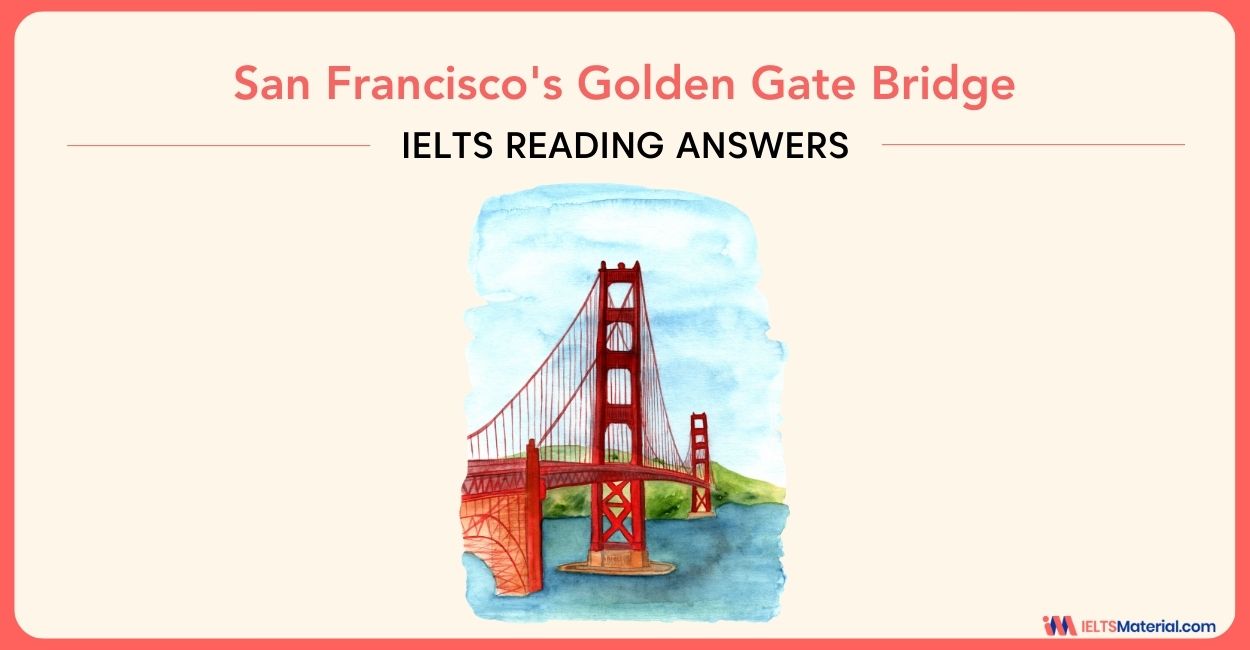San Francisco's Golden Gate Bridge IELTS Reading Answers
13 min read
Updated On
-
Copy link
Explore San Francisco's Golden Gate Bridge IELTS Reading Answers with step-by-step solutions, vocabulary highlights, and proven strategies to help you tackle tricky questions and boost your performance in the IELTS Reading section.
Table of Contents

Limited-Time Offer : Access a FREE 10-Day IELTS Study Plan!
San Francisco's Golden Gate Bridge is a passage that appeared in the IELTS General Reading exam. With diligent practice of this passage, you can ensure that your Reading skills are up to the mark and the reading module can be the top-scoring category for you. So, understand how to approach and answer the different question types in the reading module to achieve a top score.
There are 13 questions in total in the reading passage, San Francisco’s Golden Gate Bridge. You must understand the subject, look up key terms in the IELTS reading passages, and then respond in line with the instructions.
The question types found in this passage are:
- Matching Information (Q. 1-8)
- Sentence Completion (Q. 9-13)
Practice the reading passage, San Francisco's Golden Gate Bridge, below, and for more, try IELTS reading practice tests. But, before you take the test, learn some tips from this video to get that perfect IELTS reading score!
San Francisco's Golden Gate Bridge IELTS Reading Passage
A For several decades in the nineteenth century, there were calls to connect the rapidly growing metropolis of San Francisco to its neighbours across the mile-wide Golden Gate Strait, where San Francisco Bay opens onto the Pacific Ocean. Eventually, in 1919, officials asked the city engineer, Michael O’Shaughnessy, to explore the possibility of building a bridge. He began to consult engineers across the USA about the feasibility of doing so, and the cost. Most doubted whether a bridge could be built at all, or estimated that it would cost $100 million. However, a Chicago-based engineer named Joseph Strauss believed he could complete the project for a modest $25 to $30 million. After his proposal was accepted, Strauss set about convincing the communities on the northern end of the strait that the bridge would be to their benefit, as well as to that of San Francisco. With population centres growing fast, there was severe traffic congestion at the ferry docks, and motor vehicle travel by ferry was fast exceeding capacity.
B The bridge could not be constructed without the agreement of the US War Department, which owned the land on each side of the Strait and had the power to prevent any harbour construction that might affect shipping traffic. In 1924, San Francisco and Marin counties applied for a permit to build a bridge, and after hearing overwhelming arguments in favour of the project, the Secretary of War agreed. Despite the economic benefits promised by its supporters, the project met fierce resistance from a number of businesses – particularly ferry companies – and civic leaders. Not only would the bridge be an obstacle to shipping and spoil the bay’s natural beauty, they argued, it wouldn’t survive the sort of earthquake that had devastated the city in 1906. Eight years of legal actions followed as opponents tried to prevent it from being built.
C Meanwhile, Strauss’s team scrapped their original plans in favour of a suspension span capable of moving more than two feet to each side: this would withstand strong wind far better than a rigid structure. They also planned the two towers, and decided on a paint colour they called ‘international orange’.
D O’Shaughnessy, Strauss and the Secretary to the Mayor of San Francisco believed a special district needed to be created, with responsibility for planning, designing and financing construction. The formation of this district would enable all the counties affected by the bridge to have a say in the proceedings. This happened in 1928, when the California legislature passed an act to establish the Golden Gate Bridge and Highway District, consisting of six counties. In 1930, residents voted on the question of whether to put up their homes, their farms and their business properties as security for a $35 million bond issue to finance construction. The outcome was a large majority in favour.
However, the District struggled to find a financial backer amid the difficulties of the Great Depression, a problem made worse by years of expensive legal proceedings. Now desperate, Strauss personally sought help from the President of Bank of America, who provided a crucial boost by agreeing to buy $6 million in bonds in 1932.
E Construction began in January 1933, with the excavation of a vast amount of rock to establish the bridge’s two anchorages – the structures in the ground that would take the tension from the suspension cables. The crew consisted of virtually anyone capable of withstanding the physical rigours of the job, as out-of-work cab drivers, farmers and clerks lined up for the chance to earn steady wages as ironworkers and cement mixers. The attempt to build what would be the first bridge support in the open ocean proved an immense challenge. Working from a long framework built out from the San Francisco side, divers plunged to depths of 90 feet through strong currents to blast away rock and remove the debris. The framework was damaged when it was struck by a ship in August 1933 and again during a powerful storm later in the year, setting construction back five months.
F The two towers were completed in June 1935, and a New Jersey-based company was appointed to handle the on-site construction of the suspension cables. Its engineers had mastered a technique in which individual steel wires were banded together in spools and carried across the length of the bridge on spinning wheels. Given a year to complete the task, they instead finished in just over six months, having spun more than 25,000 individual wires into each massive cable.
The roadway was completed in April 1937, and the bridge officially opened to pedestrians the following month. The next day, President Roosevelt announced its opening via White House telegraph.
G The Golden Gate has endured as a marvel of modern engineering; its main span was the longest in the world for a suspension bridge until 1981, while its towers made it the tallest bridge of any type until 1993. It withstood a destructive earthquake in 1989 and was closed to traffic only three times in its first 75 years due to weather conditions. Believed to be the most photographed bridge in the world, the American Society of Civil Engineers named this landmark one of the seven civil engineering wonders of the United States in 1994.
Want to boost your IELTS score? Enroll in our expert-led IELTS online classes today!
San Francisco's Golden Gate Bridge IELTS Reading Questions
Questions 1-8
- The text above has seven sections, A-G.
- Which section mentions the following?
- Write the correct letter, A-G, in boxes 1-8 on your answer sheet. NB You may use any letter more than once.
1 why it was easy to recruit workers to build the bridge
2 a change in the design of the bridge
3 opposition to building the bridge
4 why a bridge was desirable
5 problems with raising funding for the bridge
6 permission being given to build the bridge
7 which records the bridge broke
8 the idea that building a bridge might be impossible
Questions 9-13
- Complete the sentences below.
- Choose ONE WORD ONLY from the text for each answer.
- Write your answers in boxes 9-13 on your answer sheet.
9 Building the bridge required a ………………… issued by the Secretary of War.
10 One objection to building the bridge was that another ………………… would destroy it.
11 Construction was delayed when the framework was damaged by a ship and again by a …………………
12 The last part of the bridge to be constructed was the …………………
13 The bridge was first used by ………………… in May 1937.
Want to improve your IELTS Academic Reading score? Grab Our IELTS Reading Ebook Today!
San Francisco’s Golden Gate Bridge IELTS Reading Answers
Let’s now review the answers to the questions from the passage in the reading section, San Francisco's Golden Gate Bridge IELTS Reading Answers, and assess your improvement for a high IELTS Reading band score.
1 Answer: E
Question type: Matching Information
Answer location: Paragraph E, Line 2
Answer explanation: In the given location, it is mentioned that “The crew consisted of virtually anyone capable of withstanding the physical rigours of the job, as out-of-work cab drivers, farmers and clerks lined up for the chance to earn steady wages as ironworkers and cement mixers.”. This means that the fifth paragraph mentions that it was easy to recruit workers for making the bridge as anyone who was out of work and was interested to withstand difficulties of physical labour was hired. Hence, the answer is E.
2 Answer: C
Question type: Matching Information
Answer location: Paragraph C
Answer explanation: In the third paragraph, it is given that “Meanwhile, Strauss’s team scrapped their original plans in favour of a suspension span capable of moving more than two feet to each side: this would withstand strong wind far better than a rigid structure.”. In other words, the third paragraph informs about the change in the design of the bridge. Hence, the answer is C.
3 Answer: B
Question type: Matching Information
Answer location: Paragraph B, Line 2
Answer explanation: In the cited location, it is stated that “…and after hearing overwhelming arguments in favour of the project, the Secretary of War agreed. Despite the economic benefits promised by its supporters, the project met fierce resistance from a number of businesses – particularly ferry companies – and civic leaders.”. It can be concluded that the second paragraph discusses the opposition to building the bridge through the use of the term ‘met fierce opposition’. Hence, the answer is B.
4 Answer: A
Question type: Matching Information
Answer location: Paragraph A, Line 1-Line 2
Answer explanation: In the quoted section, it is communicated that “For several decades in the nineteenth century, there were calls to connect the rapidly growing metropolis of San Francisco to its neighbours across the mile-wide Golden Gate Strait, where San Francisco Bay opens onto the Pacific Ocean. Eventually, in 1919, officials asked the city engineer, Michael O’Shaughnessy, to explore the possibility of building a bridge.”. It indicates that Paragraph A deals with the reason for building the Golden Gate Bridge in San Francisco. Hence, the answer is A.
5 Answer: D
Question type: Matching Information
Answer location: Paragraph D, Line 6
Answer explanation: In the cited paragraph, it is given “One way to cut back on water consumption is simply to prevent leaks…The modern approach, however, is to see used water as a resource which can be put to good use – either in irrigation or, after careful treatment, as recycled domestic water.”. It can be deduced that the fourth paragraph refers to the problems with raising funding for the bridge. Hence, the answer is D.
6 Answer: B
Question type: Matching Information
Answer location: Paragraph B, Line 1 & Line 5
Answer explanation: From the specified lines, “The bridge could not be constructed without the agreement of the US War Department, which owned the land on each side of the Strait…Eight years of legal actions followed as opponents tried to prevent it from being built.”, it can be concluded that the second paragraph explains that after eight years of legal battle permission was finally given to build the bridge. Hence, the answer is B.
7 Answer: G
Question type: Matching Information
Answer location: Paragraph G, Line 1 & Line 3
Answer explanation: In the concluding paragraph, it is given that “The Golden Gate has endured as a marvel of modern engineering; its main span was the longest in the world for a suspension bridge until 1981, while its towers made it the tallest bridge of any type until 1993…Believed to be the most photographed bridge in the world, the American Society of Civil Engineers named this landmark one of the seven civil engineering wonders of the United States in 1994.”. Based on this reference, it can be said that in the last paragraph, the writer is informing us about records the bridge broke as the first suspension bridge and the most photographed bridge in the world. Hence, the answer is G.
8 Answer: A
Question type: Matching Information
Answer location: Paragraph A, Line 4
Answer explanation: In the extracted line, it is mentioned that “Most doubted whether a bridge could be built at all, or estimated that it would cost $100 million.”. This statement indicates that the first paragraph mentions that there was an idea that building a bridge might be impossible. Hence, the answer is A.
9 Answer: permit
Question type: Sentence Completion
Answer location: Paragraph B, Line 2
Answer explanation: In the mentioned line, it is specified that “In 1924, San Francisco and Marin counties applied for a permit to build a bridge…the Secretary of War agreed”. It can be inferred that the building of the bridge was not possible without the permission of the Secretary of State. Hence, the answer is ‘permit’.
10 Answer: earthquake
Question type: Sentence Completion
Answer location: Paragraph B, Line 4
Answer explanation: In the indicated line, it is said that “…they argued, it wouldn’t survive the sort of earthquake that had devastated the city in 1906.”. In other words, one of the objections against building the bridge was that it would not survive an earthquake like the one in 1906 that devastated the city of San Francisco. Hence, the answer is ‘earthquake’.
11 Answer: storm
Question type: Sentence Completion
Answer location: Paragraph E, Line 5
Answer explanation: In the respective section, it is noted that “The framework was damaged when it was struck by a ship in August 1933 and again during a powerful storm later in the year, setting construction back five months.”. Based on the reference, it can be said that besides the framework of the bridge being stuck by a ship and later, the construction was delayed because a storm affected the construction process. Hence, the answer is ‘storm’.
12 Answer: roadway
Question type: Sentence Completion
Answer location: Paragraph F, Line 4
Answer explanation: In the specified line, it is mentioned that “The roadway was completed in April 1937, and the bridge officially opened to pedestrians the following month.”. It can be said that the last part of the bridge to be completed was the roadways, after which the bridge was opened to the public. Hence, the answer is ‘roadway’.
13 Answer: pedestrians
Question type: Sentence Completion
Answer location: Paragraph F, Line 4
Answer explanation: In the cited line, it is stated that “The roadway was completed in April 1937, and the bridge officially opened to pedestrians the following month.”. It can be concluded from the above-mentioned line that once the roadways were completed in April, 1937, the bridge was opened to the pedestrians after a month, which was in May, 1937. Hence, the answer is ‘pedestrians’.
Tips to Solve the Question Types in San Francisco’s Golden Gate Bridge IELTS Reading Answers
Let us check out some quick IELTS Exam Preparation Tips for Band Score of 8+ to answer the three types of questions in the Reading Answers.
Matching Information:
In this sort of question, you will be given a list of three to six statements, and you will need to match the information in each statement to the matching idea in a paragraph in the reading passage.
- You will get an idea of the main idea of each statement by reading the instructions, followed by the list of statements. Also, figure out the keywords from each statement.
- Use reading techniques to go through the text and find out which paragraph or section contains the relevant information of the statements.
- While one statement corresponds to one passage, some passages may not have any answer. Remember this to avoid repetition or wasting your time.
- Once you identify the keywords and find the corresponding paragraph that contains the information, follow this process for the others.
Sentence Completion:
In the sentence completion of the IELTS Reading test, you will be asked to fill in the blanks in incomplete phrases with the relevant words or numbers.
- Read the instructions carefully. It will help you determine the word limit (no more than two, one word, etc) and important terms like ‘using words from the text’ or ‘from the text’. You have to follow these strictly.
- Read the incomplete sentences first. Also, think about keywords and how they could be represented by synonyms or paraphrasing.
- Locate where the information is by scanning quickly. If you can’t, move on.
- Study the reading text by using the skimming and scanning techniques. It will help to establish the answer quickly. When scanning for your answer, make sure you are thinking about paraphrasing and synonyms.
- The answers appear in the same order as the questions.Also, check your spelling and remember that your answer should be grammatically correct.
Confused about IELTS prep? Join our exclusive IELTS webinar and clear all your doubts!
Mastering passages like “San Francisco's Golden Gate Bridge IELTS Reading Answers” can significantly boost your Reading IELTS band score. Regular practice with real exam-style questions not only improves speed and accuracy but also builds your confidence. Keep exploring different IELTS Reading passages and refine your techniques to ensure success on test day.
Check More IELTS Reading Answers
| Cod In Trouble Reading Answers | Why Pagodas Don’t Fall Down Answers |
| Anxiety Reading Answers | Australias Sporting Success Answers |
| Saving Language Reading Answers | A Book Review Reading Answers |
Also check :

Start Preparing for IELTS: Get Your 10-Day Study Plan Today!
Recent Articles

Kasturika Samanta

Kasturika Samanta


Kasturika Samanta




Post your Comments